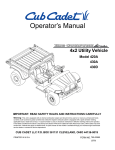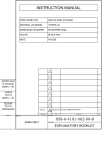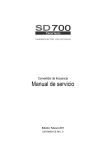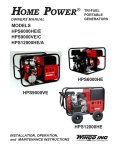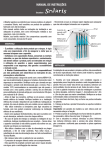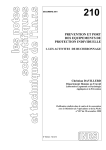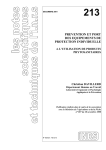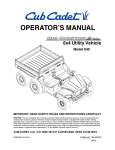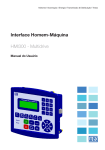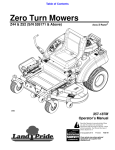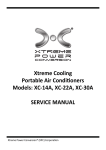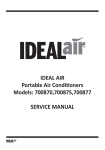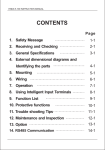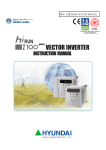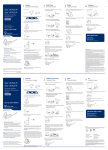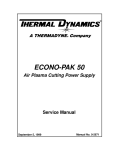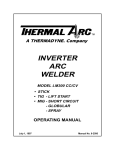Download Model TA-10/270 H Service Manual
Transcript
Model TA-10/270 H PREDATOR AC/DC CC/CV Welding Generator STICK MIG AUXILIARY POWER Service Manual 4/1/02 Manual No. 430429-493 GENERAL INFORMATION 2 Table of Contents SECTION 1: GENERAL INFORMATION ............................................................................................................ 6 1.01 Notes, Cautions and Warnings.......................................................................................................................... 6 1.02 Important Safety Precautions ............................................................................................................................ 6 1.03 Publications ........................................................................................................................................................ 7 1.04 Note, Attention et Avertissement...................................................................................................................... 8 1.05 Precautions De Securite Importantes ................................................................................................................ 8 1.06 Documents De Reference................................................................................................................................10 SECTION 2: TECHNICAL SPECIFICATIONS...................................................................................................11 2.01 Specifications ....................................................................................................................................................11 2.02 Volt-Amp Curve ...............................................................................................................................................11 2.03 Duty Cycle.........................................................................................................................................................11 2.04 Front Panel Descriptions ..................................................................................................................................12 2.05 Dimensions and Weight ...................................................................................................................................13 2.06 Maximum Welding Generator Operating Angles...........................................................................................13 2.07 Installing Welding Generator ...........................................................................................................................13 2.08 Location.............................................................................................................................................................13 2.09 Air Flow Clearance...........................................................................................................................................14 2.10 Generator Auxiliary Power System .................................................................................................................15 2.11 Wiring Optional 230 Volt Plug........................................................................................................................15 2.12 Grounding The Generator ................................................................................................................................15 2.13 When Connecting To Home, Shop, or Farm Wiring......................................................................................16 2.14 Auxiliary Power Requirements........................................................................................................................16 2.15 Simultaneous Welding and Power...................................................................................................................18 2.16 Selecting and Preparing Weld Output Cables .................................................................................................18 SECTION 3: TROUBLE SHOOTING GUIDE ....................................................................................................20 3.01 There Is No Auxiliary Voltage and/or Welding Current ................................................................................20 3.02 The Generator Is De-Energized when Load is connected ..............................................................................21 3.03 Excessive Fall of Voltage When The Load is Connected...............................................................................21 3.04 Single Phase Receptacle Out Of Balance When at Idling ..............................................................................21 3.05 Insufficient Welding Current............................................................................................................................21 3.06 The Battery Runs down Frequently .................................................................................................................22 SECTION 4: CIRCUIT TESTING..........................................................................................................................23 Date 04/01/02 3 Manual 4.01 Checking the Resistance of the Stator Windings.............................................................................................23 4.02 Replacing the Stator..........................................................................................................................................23 4.03 Excitation Capacitors........................................................................................................................................24 4.04 Output Rectifier.................................................................................................................................................24 4.05 Auto Idle Circuit ...............................................................................................................................................24 4.06 Engine Oil Shut-Down Circuit Tests. ..............................................................................................................25 4.07 Engine Charge Circuit Shut-Down Test..........................................................................................................25 SECTION 5: PARTS LIST.......................................................................................................................................26 5.01 Revision A & B.................................................................................................................................................26 5.02 Revision C.........................................................................................................................................................30 5.03 Revision D.........................................................................................................................................................40 5.04 With Kohler Engine..........................................................................................................................................48 5.05 Common Engine Part Numbers .......................................................................................................................54 5.06 Propane Engine Conversion Parts....................................................................................................................55 SECTION 6: SCHEMATICS ...................................................................................................................................57 Revision A.................................................................................................................................................................57 Revision B .................................................................................................................................................................58 Revision C .................................................................................................................................................................59 Revision D.................................................................................................................................................................60 Revision with Kohler Engine ...................................................................................................................................61 APPENDIX A ..............................................................................................................................................................62 GENERAL INFORMATION 4 Date 04/01/02 5 Manual when cutting or welding any metals which may contain one or more of the following: SECTION 1: GENERAL INFORMATION 1.01 Notes, Cautions and Warnings Throughout this manual, notes, cautions, and warnings are used to highlight important information. These highlights are categorized as follows: NOTE An operation, procedure, or background information which requires additional emphasis or is helpful in efficient operation of the system. CAUTION A procedure which, if not properly followed, may cause damage to the equipment. WARNING A procedure which, if not properly followed, may cause injury to the operator or others in the operating area. Antimony Arsenic Barium Beryllium Cadmium Chromium Cobalt Copper Lead Manganese Mercury Nickel Selenium Silver Vanadium • Always read the Material Safety Data Sheets (MSDS) that should be supplied with the material you are using. These MSDSs will give you the information regarding the kind and amount of fumes and gases that may be dangerous to your health. • For information on how to test for fumes and gases in your workplace, refer to item 1 in Subsection 1.03, Publications in this manual. • Use special equipment, such as water or down draft welding/cutting tables, to capture fumes and gases. • Do not use the welding torch in an area where combustible or explosive gases or materials are located. • Phosgene, a toxic gas, is generated from the vapors of chlorinated solvents and cleansers. Remove all sources of these vapors. 1.02 Important Safety Precautions WARNING OPERATION AND MAINTENANCE OF ARC WELDING EQUIPMENT CAN BE DANGEROUS AND HAZARDOUS TO YOUR HEALTH. To prevent possible injury, read, understand and follow all warnings, safety precautions and instructions before using the equipment. Call 1603-298-5711 or your local distributor if you have any questions. GASES AND FUMES ELECTRIC SHOCK Electric Shock can injure or kill. The arc welding process uses and produces high voltage electrical energy. This electric energy can cause severe or fatal shock to the operator or others in the workplace. • Never touch any parts that are electrically “live” or “hot.” • Wear dry gloves and clothing. Insulate yourself from the work piece or other parts of the welding circuit. • Repair or replace all worn or damaged parts. Gases and fumes produced during the Arc welding/cutting process can be dangerous and hazardous to your health. • Extra care must be taken when the workplace is moist or damp. • Keep all fumes and gases from the breathing area. Keep your head out of the welding fume plume. • Install and maintain equipment according to NEC code, refer to item 4 in Subsection 1.03, Publications. • Use an air-supplied respirator if ventilation is not adequate to remove all fumes and gases. • Disconnect power source before performing any service or repairs. • The kinds of fumes and gases from the arc welding/cutting depend on the kind of metal being used, coatings on the metal, and the different processes. You must be very careful • Read and follow all the instructions in the Operating Manual. GENERAL INFORMATION 6 • Keep helmet and safety glasses in good condition. Replace lenses when cracked, chipped or dirty. FIRE AND EXPLOSION Fire and explosion can be caused by hot slag, sparks, or the arc weld. • Protect others in the work area from the arc rays. Use protective booths, screens or shields. • Use the shade of lens as recommended in Subsection 1.03, item 4. • Be sure there is no combustible or flammable material in the workplace. Any material that cannot be removed must be protected. 1.03 Publications • Ventilate all flammable or explosive vapors from the workplace. Refer to the following standards or their latest revisions for more information: • Do not cut or weld on containers that may have held combustibles. 1. • Provide a fire watch when working in an area where fire hazards may exist. • Hydrogen gas may be formed and trapped under aluminum workpieces when they are cut underwater or while using a water table. DO NOT cut aluminum alloys underwater or on a water table unless the hydrogen gas can be eliminated or dissipated. Trapped hydrogen gas that is ignited will cause an explosion. NOISE Noise can cause permanent hearing loss. Arc welding/cutting processes can cause noise levels to exceed safe limits. You must protect your ears from loud noise to prevent permanent loss of hearing. • To protect your hearing from loud noise, wear protective ear plugs and/or ear muffs. Protect others in the workplace. • Noise levels should be measured to be sure the decibels (sound) do not exceed safe levels. • For information on how to test for noise, see item 1 in Subsection 1.03, Publications, in this manual. ARC WELDING RAYS Arc Welding/Cutting Rays can injure your eyes and burn your skin. The arc welding/cutting process produces very bright ultra violet and infra red light. These arc rays will damage your eyes and burn your skin if you are not properly protected. • To protect your eyes, always wear a welding helmet or shield. Also always wear safety glasses with side shields, goggles or other protective eye wear. • Wear welding gloves and suitable clothing to protect your skin from the arc rays and sparks. 7 OSHA, SAFETY AND HEALTH STANDARDS, 29CFR 1910, obtainable from the Superintendent of Documents, U.S. Government Printing Office, Washington, D.C. 20402 2. ANSI Standard Z49.1, SAFETY IN WELDING AND CUTTING, obtainable from the American Welding Society, 550 N.W. LeJeune Rd, Miami, FL 33126 3. NIOSH, SAFETY AND HEALTH IN ARC WELDING AND GAS WELDING AND CUTTING, obtainable from the Superintendent of Documents, U.S. Government Printing Office, Washington, D.C. 20402 4. ANSI Standard Z87.1, SAFE PRACTICES FOR OCCUPATION AND EDUCATIONAL EYE AND FACE PROTECTION, obtainable from American National Standards Institute, 1430 Broadway, New York, NY 10018 5. ANSI Standard Z41.1, STANDARD FOR MEN’S SAFETY-TOE FOOTWEAR, obtainable from the American National Standards Institute, 1430 Broadway, New York, NY 10018 6. ANSI Standard Z49.2, FIRE PREVENTION IN THE USE OF CUTTING AND WELDING PROCESSES, obtainable from American National Standards Institute, 1430 Broadway, New York, NY 10018 7. AWS Standard A6.0, WELDING AND CUTTING CONTAINERS WHICH HAVE HELD COMBUSTIBLES, obtainable from American Welding Society, 550 N.W. LeJeune Rd, Miami, FL 33126 8. NFPA Standard 51, OXYGEN-FUEL GAS SYSTEMS FOR WELDING, CUTTING AND ALLIED PROCESSES, obtainable from the National Fire Protection Association, Batterymarch Park, Quincy, MA 02269 9. NFPA Standard 70, NATIONAL ELECTRICAL CODE, obtainable from the National Fire Protection Association, Batterymarch Park, Quincy, MA 02269 10. NFPA Standard 51B, CUTTING AND WELDING PROCESSES, obtainable from the National Fire Protection Association, Batterymarch Park, Quincy, MA 02269 GENERAL INFORMATION 11.CGA Pamphlet P-1, SAFE HANDLING OF COMPRESSED GASES IN CYLINDERS, obtainable from the Compressed Gas Association, 1235 Jefferson Davis Highway, Suite 501, Arlington, VA 22202 12. CSA Standard W117.2, CODE FOR SAFETY IN WELDING AND CUTTING, obtainable from the Canadian Standards Association, Standards Sales, 178 Rexdale Boulevard, Rexdale, Ontario, Canada M9W 1R3 13. NWSA booklet, WELDING SAFETY BIBLIOGRAPHY obtainable from the National Welding Supply Association, 1900 Arch Street, Philadelphia, PA 19103 14. American Welding Society Standard AWSF4.1, RECOMMENDED SAFE PRACTICES FOR THE PREPARATION FOR WELDING AND CUTTING OF CONTAINERS AND PIPING THAT HAVE HELD HAZARDOUS SUBSTANCES, obtainable from the American Welding Society, 550 N.W. LeJeune Rd, Miami, FL 33126 15. ANSI Standard Z88.2, PRACTICE FOR RESPIRATORY PROTECTION, obtainable from American National Standards Institute, 1430 Broadway, New York, NY 10018 1.04 Note, Attention et Avertissement Dans ce manuel, les mots “note,” “attention,” et “avertissement” sont utilisés pour mettre en relief des informations à caractère important. Ces mises en relief sont classifiées comme suit : NOTE Toute opération, procédure ou renseignement général sur lequel il importe d’insister davantage ou qui contribue à l’efficacité de fonctionnement du système. ATTENTION Toute procédure pouvant résulter l’endommagement du matériel en cas de non-respect de la procédure en question. AVERTISSEMENT Toute procédure pouvant provoquer des blessures de l’opérateur ou des autres personnes se trouvant dans la zone de travail en cas de non-respect de la procédure en question. GENERAL INFORMATION 8 1.05 Precautions De Securite Importantes AVERTISSEMENT L’OPÉRATION ET LA MAINTENANCE DU MATÉRIEL DE SOUDAGE À L’ARC AU JET DE PLASMA PEUVENT PRÉSENTER DES RISQUES ET DES DANGERS DE SANTÉ. Il faut communiquer aux opérateurs et au personnel TOUS les dangers possibles. Afin d’éviter les blessures possibles, lisez, comprenez et suivez tous les avertissements, toutes les précautions de sécurité et toutes les consignes avant d’utiliser le matériel. Composez le + 603-298-5711 ou votre distributeur local si vous avez des questions. FUMÉE et GAZ La fumée et les gaz produits par le procédé de jet de plasma peuvent présenter des risques et des dangers de santé. • Eloignez toute fumée et gaz de votre zone de respiration. Gardez votre tête hors de la plume de fumée provenant du chalumeau. • Utilisez un appareil respiratoire à alimentation en air si l’aération fournie ne permet pas d’éliminer la fumée et les gaz. • Les sortes de gaz et de fumée provenant de l’arc de plasma dépendent du genre de métal utilisé, des revêtements se trouvant sur le métal et des différents procédés. Vous devez prendre soin lorsque vous coupez ou soudez tout métal pouvant contenir un ou plusieurs des éléments suivants: antimoine argent arsenic baryum béryllium cadmium chrome cobalt cuivre manganèse mercure nickel plomb sélénium vanadium • Lisez toujours les fiches de données sur la sécurité des matières (sigle américain “MSDS”); celles-ci devraient être fournies avec le matériel que vous utilisez. Les MSDS contiennent des renseignements quant à la quantité et la nature de la fumée et des gaz pouvant poser des dangers de santé. • Pour des informations sur la manière de tester la fumée et les gaz de votre lieu de travail, consultez l’article 1 et les documents cités à la page 5. • Utilisez un équipement spécial tel que des tables de coupe à débit d’eau ou à courant descendant pour capter la fumée et les gaz. • N’utilisez pas le chalumeau au jet de plasma dans une zone où se trouvent des matières ou des gaz combustibles ou explosifs. • Le phosgène, un gaz toxique, est généré par la fumée provenant des solvants et des produits de nettoyage chlorés. Eliminez toute source de telle fumée. CHOC ELECTRIQUE Les chocs électriques peuvent blesser ou même tuer. Le procédé au jet de plasma requiert et produit de l’énergie électrique haute tension. Cette énergie électrique peut produire des chocs graves, voire mortels, pour l’opérateur et les autres personnes sur le lieu de travail. • Ne touchez jamais une pièce “sous tension” ou “vive”; portez des gants et des vêtements secs. Isolez-vous de la pièce de travail ou des autres parties du circuit de soudage. • Réparez ou remplacez toute pièce usée ou endommagée. • Prenez des soins particuliers lorsque la zone de travail est humide ou moite. • Montez et maintenez le matériel conformément au Code électrique national des Etats-Unis. (Voir la page 5, article 9.) • Débranchez l’alimentation électrique avant tout travail d’entretien ou de réparation. • Lisez et respectez toutes les consignes du Manuel de consignes. • Procurez une bonne aération de toutes les fumées inflammables ou explosives. • Ne coupez pas et ne soudez pas les conteneurs ayant pu renfermer des matières combustibles. • Prévoyez une veille d’incendie lors de tout travail dans une zone présentant des dangers d’incendie. • Le gas hydrogène peut se former ou s’accumuler sous les pièces de travail en aluminium lorsqu’elles sont coupées sous l’eau ou sur une table d’eau. NE PAS couper les alliages en aluminium sous l’eau ou sur une table d’eau à moins que le gas hydrogène peut s’échapper ou se dissiper. Le gas hydrogène accumulé explosera si enflammé. RAYONS D’ARC DE PLASMA Les rayons provenant de l’arc de plasma peuvent blesser vos yeux et brûler votre peau. Le procédé à l’arc de plasma produit une lumière infra-rouge et des rayons ultra-violets très forts. Ces rayons d’arc nuiront à vos yeux et brûleront votre peau si vous ne vous protégez pas correctement. • Pour protéger vos yeux, portez toujours un casque ou un écran de soudeur. Portez toujours des lunettes de sécurité munies de parois latérales ou des lunettes de protection ou une autre sorte de protection oculaire. • Portez des gants de soudeur et un vêtement protecteur approprié pour protéger votre peau contre les étincelles et les rayons de l’arc. • Maintenez votre casque et vos lunettes de protection en bon état. Remplacez toute lentille sale ou comportant fissure ou rognure. • Protégez les autres personnes se trouvant sur la zone de travail contre les rayons de l’arc en fournissant des cabines ou des écrans de protection. • Respectez le teint de lentille recommandé dans le article 4, page 5. INCENDIE ET EXPLOSION Les incendies et les explosions peuvent résulter des scories chaudes, des étincelles ou de l’arc de plasma. Le procédé à l’arc de plasma produit du métal, des étincelles, des scories chaudes pouvant mettre le feu aux matières combustibles ou provoquer l’explosion de fumées inflammables. • Soyez certain qu’aucune matière combustible ou inflammable ne se trouve sur le lieu de travail. Protégez toute telle matière qu’il est impossible de retirer de la zone de travail. 9 • Hydrogen gas may be present under aluminum workpieces during the cutting process when being cut underwater or using a water table. DO NOT cut aluminum underwater or on a water table unless the hydrogen gas can be eliminated as the hydrogen gas may detonate. BRUIT GENERAL INFORMATION Le bruit peut provoquer une perte permanente de l’ouïe. Les procédés de soudage à l’arc de plasma peuvent provoquer des niveaux sonores supérieurs aux limites normalement acceptables. Vous dú4ez vous protéger les oreilles contre les bruits forts afin d’éviter une perte permanente de l’ouïe. • Pour protéger votre ouïe contre les bruits forts, portez des tampons protecteurs et/ou des protections auriculaires. Protégez également les autres personnes se trouvant sur le lieu de travail. • Il faut mesurer les niveaux sonores afin d’assurer que les décibels (le bruit) ne dépassent pas les niveaux sûrs. • Pour des renseignements sur la manière de tester le bruit, consultez l’article 1, page 5. 1.06 Documents De Reference Consultez les normes suivantes ou les révisions les plus récentes ayant été faites à celles-ci pour de plus amples renseignements : 1. OSHA, NORMES DE SÉCURITÉ DU TRAVAIL ET DE PROTECTION DE LA SANTÉ, 29CFR 1910, disponible auprès du Superintendent of Documents, U.S. Government Printing Office, Washington, D.C. 20402 2. Norme ANSI Z49.1, LA SÉCURITÉ DES OPÉRATIONS DE COUPE ET DE SOUDAGE, disponible auprès de la Société Américaine de Soudage (American Welding Society), 550 N.W. LeJeune Rd., Miami, FL 33126 3. NIOSH, LA SÉCURITÉ ET LA SANTÉ LORS DES OPÉRATIONS DE COUPE ET DE SOUDAGE À L’ARC ET AU GAZ, disponible auprès du Superintendent of Documents, U.S. Government Printing Office, Washington, D.C. 20402 4. Norme ANSI Z87.1, PRATIQUES SURES POUR LA PROTECTION DES YEUX ET DU VISAGE AU TRAVAIL ET DANS LES ECOLES, disponible de l’Institut Américain des Normes Nationales (American National Standards Institute), 1430 Broadway, New York, NY 10018 5. Norme ANSI Z41.1, NORMES POUR LES CHAUSSURES PROTECTRICES, disponible auprès de l’American National Standards Institute, 1430 Broadway, New York, NY 10018 6. Norme ANSI Z49.2, PRÉVENTION DES INCENDIES LORS DE L’EMPLOI DE PROCÉDÉS DE COUPE ET DE SOUDAGE, disponible auprès de l’American National GENERAL INFORMATION 10 Standards Institute, 1430 Broadway, New York, NY 10018 7. Norme A6.0 de l’Association Américaine du Soudage (AWS), LE SOUDAGE ET LA COUPE DE CONTENEURS AYANT RENFERMÉ DES PRODUITS COMBUSTIBLES, disponible auprès de la American Welding Society, 550 N.W. LeJeune Rd., Miami, FL 33126 8. Norme 51 de l’Association Américaine pour la Protection contre les Incendies (NFPA), LES SYSTEMES À GAZ AVEC ALIMENTATION EN OXYGENE POUR LE SOUDAGE, LA COUPE ET LES PROCÉDÉS ASSOCIÉS, disponible auprès de la National Fire Protection Association, Batterymarch Park, Quincy, MA 02269 9. Norme 70 de la NFPA, CODE ELECTRIQUE NATIONAL, disponible auprès de la National Fire Protection Association, Batterymarch Park, Quincy, MA 02269 10. Norme 51B de la NFPA, LES PROCÉDÉS DE COUPE ET DE SOUDAGE, disponible auprès de la National Fire Protection Association, Batterymarch Park, Quincy, MA 02269 11. Brochure GCA P-1, LA MANIPULATION SANS RISQUE DES GAZ COMPRIMÉS EN CYLINDRES, disponible auprès de l’Association des Gaz Comprimés (Compressed Gas Association), 1235 Jefferson Davis Highway, Suite 501, Arlington, VA 22202 12. Norme CSA W117.2, CODE DE SÉCURITÉ POUR LE SOUDAGE ET LA COUPE, disponible auprès de l’Association des Normes Canadiennes, Standards Sales, 178 Rexdale Boulevard, Rexdale, Ontario, Canada, M9W 1R3 13. ivret NWSA, BIBLIOGRAPHIE SUR LA SÉCURITÉ DU SOUDAGE, disponible auprès de l’Association Nationale de Fournitures de Soudage (National Welding Supply Association), 1900 Arch Street, Philadelphia, PA 19103 14. Norme AWSF4.1 de l’Association Américaine de Soudage, RECOMMANDATIONS DE PRATIQUES SURES POUR LA PRÉPARATION À LA COUPE ET AU SOUDAGE DE CONTENEURS ET TUYAUX AYANT RENFERMÉ DES PRODUITS DANGEREUX , disponible auprès de la American Welding Society, 550 N.W. LeJeune Rd., Miami, FL 33126 15. Norme ANSI Z88.2, PRATIQUES DE PROTECTION RESPIRATOIRE, disponible auprès de l’American National Standards Institute, 1430 Broadway, New York, NY 10018 SECTION 2: TECHNICAL SPECIFICATIONS 2.01 Specifications The Thermal Arc TA-10/270-H is a gasoline engine driven DC welding generator with selectable Constant Current (CC) and Constant Voltage (CV) output characteristics. This unit is designed for use with Shielded Metal Arc Welding (SMAW), Gas Metal Arc Welding (GMAW), and GAS Tungsten Arc Welding - (GTAW) processes. A digital amperage/voltage meter is optional. Specifications Amperage Range Duty Cycle AC/DC welding current Volt Range CV Mode OCV CC Mode Auxiliary Power Single Phase Single Phase Three Phase Engine Make/Type Model series Number of cylinders Displacement Power Engine Speed Engine speed Cooling system Oil capacity Fuel capacity Fuel consumption Battery AC DC 40 – 300 300 @ 60% 250 @ 100% -100 40 – 270 270 @ 60% 250 @ 100% 16 – 30 100 115 115/240 460 Amperage Current Ranges 40 - 70 40 – 60 70 – 135 40 – 90 155 – 240 90 – 170 200 – 270 170 – 260 260 – 300 220 – 270 2ea GFCI Duplex Receptacles 3.5Kva 8.5Kva 10Kva HONDA GX 620 & 620K1 2 614 cc. 20 HP 3750 rpm no load 2600 rpm Idle Air 1.5 l. - 0,42 gl. 37.5 l. - 10 gl. 5.2 l/h – 1.4 gl./Hr 12V 340A 2.02 Volt-Amp Curve KOHLER COMMAND 20 2 614CC 20HP 3750 rpm no load 2600 rpm Idle Air 2.1 l – 0.56gl 37.5 l – 10 gl 5.2 l/Hr 12V 340A NOTE Volt-ampere curves show the voltage and amperage output capabilities of the welding power source. Curves of other settings will fall between the curves shown. 2.03 Duty Cycle 11 The duty cycle of a welding generator is the percentage of a ten-minute period that a welding generator can be operated at a given output without causing overheating and damaging of the unit. This unit is rated at 60 percent duty cycle when operated at 270 amperes. The unit can be operated at 270 amperes for six consecutive minutes, but it must operate at no load for the remaining four minutes to allow proper cooling. if the welding amperes decrease, the duty cycle increases. If INTRODUCTION the welding amperes are increased beyond rated output, the duty cycle will decrease. CAUTION: CONTINUAL EXCEEDING OF DUTY CYCLE RATINGS CAN CAUSE DAMAGE TO THE WELDING POWER SOURCE. 2.04 Front Panel Descriptions 1 2 3 4 5 6 7 1 2 3 4 5 6 7 8 9 10 8 9 Use to select welding current for CC mode and CV for MIG mode Battery Charge Lamp-Should the charging circuit fail the Battery Charging Lamp will turn on and unit will turn off. Fine adjustment-controls throttle for fine welding control of current CC and voltage CV Rotating this control in a clockwise direction increases the amperage or voltage output. The scale surrounding the control represents approximate actual amperage or voltage values. Oil Level lamp-Should the oil sensor in the engine detect a low oil condition the Oil Level Lamp will turn on and engine will shut off. Polarity switch-Sets welding polarity for DC Negative, DC Positive or AC. Serial Number. Welding Receptacle: Positive-Positive output welding connection for CC ( Constant Current ) and CV ( Constant Voltage ). Amperage meter ( optional ). Volt Meter ( optional ). Welding Receptacle: Negative-Negative output welding connection for CC ( Constant Current ) STICK an TIG. 10 11 1 2 12 115V 20A Circuit Breakers – Push to reset. Controls 115V power source for the 115V duplex GFCI receptacles 230/115V Single Phase Receptacle Supplies 60 Hz single-phase power at weld/power speed. Engine RUN/STOP Switch – Place in the RUN position to operate generator. Use the START BUTTON to start engine. To shut off engine place switch in STOP position. Start Button - Used to start the engine. Set the RUN/START switch to RUN, push START Button to start engine. When engine starts release button. Choke – for easier starting. Hour meter - Monitors Time in hours when the engine is on. Engine: Auto/high switch – When in Auto the unit will idle until a load is applied. In High position the engine will operate above idle RPM. Fuel Gauge - Monitors fuel level. Earth Connection - used to earth ground the generator fot auxiliary power. 230/115V Circuit Breakers – Push to reset. Controls 230/115V power source for the 230/115V receptacle. GFCI 115V Duplex Receptacles - Ground fault interrupt protection receptacle for 115V 60Hz power source. Circuit breaker - 3 pole circuit breaker controls 460V three phase power source 460V Output - Access for three phase 460V 60 Hz connections. Connect Line1, 2 and 3 to the output side of the circuit breaker and the ground to the bolt mounted beside the circuit breaker 1) Lifting Eye. Use lifting eye or lifting forks to move unit. If using lifting forks, extend forks beyond opposite side of unit. 1) Trailer - Install unit on trailer according to trailer manufacturing. 2.05 Dimensions and Weight Height Width Length A B C D E 710mm 530mm 1080mm 15mm 1050mm 33mm 424mm 10.5mm Dia. 27.9” 20.86” 42.52” .59” 41.34” 1.30” 16.69” .41” Dia. Weight 248 Kg 546.5 lb Movement - Do not lift unit from end. 2.08 Location A proper installation site should be selected for the welding generator if the unit is to provide dependable service and remain relaticely maintenance free. 2.06 Maximum Welding Generator Operating Angles Do not exceed operating angles while running or engine damage will occur. CAUTION: OPERATE IN OPEN, WELL VENTILATED AREAS, OR IF OPERATED INDOORS, VENT ENGINE EXHAUST OUTSIDE THE BUILDING. KEEP ENGINE EXHAUST OUTLET AWAY FROM BUILDING AIR INTAKES. The operating angle is a maximum of 25 degrees. 2.07 Installing Welding Generator 1) Lifting forks. 13 INTRODUCTION 2.09 Air Flow Clearance WARNING: ENGINE FUEL CAN CAUSE FIRE OR EXPLOSION. • • • Maintain at least 19.7 inch (500mm) of unrestricted space on all sides of the unit, and keep underside free of obstructions. Do not place any filtering device over the intake air passages of this welding generator. Warranty is void if any type of filtering device is used. The service life and operating efficiency of this unit are reduced when the unit is subjected to high levels of dust, dirt, moisture, and corrosive vapors. WARNING: SPARKS CAN CAUSE BATTERY GASES TO EXPLODE BATTERY ACID CAN BURN EYES AND SKIN. • • • • • • • Stop engine before disconnecting or connecting battery cables. Always wear a faceshield and proper protective cloting when working on battery. Do not allow tools to cause sparks when working on a battery. Place the engine control switch in the STOP position. Remove bolts and pull out tray. Connect the cables Reinstall battery tray. 14 Stop engine before fueling. Do not fuel while smoking or near sparks or flames. Do not overfill tank-clean up any spilled fuel. REMOVE FUEL CAP SLOWLY-FUEL SPRAY MAY CAUSE INJURYFUEL MY BE UNDER PRESSURE. Rotate fuel cap slowly and wait until hissing stops before removing cap. Check all fluids daily. Engine must be cold and on a level surface. Add fresh fuel starting engine the first time. 2.10 Generator Auxiliary Power System Standard Receptacles (1) Circuit breakers to protect (11) GFCI receptacles from overload. (2) 240 V 50 A AC receptacle. Supplies 60 Hz singlephase power at maximum speed (3600 rpm). Maximum output is 8.5 kVA/kW. (11) 120 V 15 A AC Duplex GFCI receptacle. Supplies 60 Hz single-phase power at maximum speed (3600 rpm). Maximum output each receptacle is 1.8 kVA/kW. (10) Circuit breakers to protect (2) 240 V receptacle from overload. Select proper insolating and grounded equipment. (9) Earth ground connection. 1) Auxiliary power receptacles are Neutral bonded to frame. 2) 3-Prong plug for case Grounded equipment 3) 2-Prong plug for double insulated equipment. 460 V 13 A AC three phase Circuit Breaker connection. Supplies 60 Hz three-phase power at maximum speed (3600 rpm). Maximum output is 10 kVA/kW. To connect load remove the two retaining knobs holding the access panel. After opening the panel connect a cable to be used to supply the 460V three phase load to the three phase circuit breaker mounted to the access panel. Connected the ground cable to the bolt mounted next to the circuit breaker. Route the cable through the cable clamp and secure cable. Resecure the access panel with the two retaining knobs to the front panel. 2.12 Grounding The Generator TO A TRUCK OR TRAILER FRAME 1. 2. 3. 4. Generator base. Metal vehicle frame. Equipment grounding terminal. Grounding cable. Use # 10 AGW or larger insulated copper wire. 2.11 Wiring Optional 230 Volt Plug The plug can be wired for a 230V, 2-wire load or a 115/230V, 3-wire load. See diagram below White - Neutral terminal. YYY - Load 1 terminal. XXX - Load 2 terminal. Green - Ground terminal. 15 INTRODUCTION 4. Circuit Breaker or Fused Disconnect Switch. Obtain and install correct switch. 5. Extension Cord. Select as shown in the Extension Cord Selection Chart. 6. Generator Connections. Connect terminals or plug of adequate amperage capacity to cord. Follow all applicable codes and safety practices. Turn off or unplug all equipment connected to generator before starting or stopping engine. When starting or stopping, the engine has low speed which causes low voltage and frequency. 7. Load connections. NOTE: FOR THE GFCI RECEPTACLES TO PERFORM PROPER PROTECTION THE WELDING GENERATOR MUST BE EARTH GROUNDED. 2.13 When Connecting To Home, Shop, or Farm Wiring NOTE: THIS UNIT SHOULD NEVER BE USED AS THE MAIN SOURCE OF POWER. 1) Equipment grounding terminal. 1) Grounding cable. Use # 10 AGW or lager insulated copper wire. 1) Water meter. 1) Metal water pipe 1) Driven ground rod. Customer-supplied equipment is required if generator is to supply standby power during emergencies or power outages. 2.14 Auxiliary Power Requirements The following section provides some general guidelines for the installation and operation of an auxiliary power generator. not all the guidelines may be applicable to this specific unit. Typical connection to supply emergency or standby power. The auxiliary power supplied form the generator is most commonly used in industrial, small business and residential applications. For industrial applications, a portable unit can be moved the job site to power portable tools, lights, compressors, etc. For small business and residential applications, the generator supplies standby power during a power outage. 1. Power Company Service Meter. 2. Main and Branch Over-current Protection. 3. Double-Pole, Double-Throw Transfer Switch. Obtain and install correct switch. Switch rating must be same as or greater than the branch overcurrent protection. 16 It is the installer’s responsibility to follow all applicable codes when installing an auxiliary power generator. It is also the installer’s responsibility to determine if the generator is capable of supplying adequate power for a specific application. When installing consult qualified local personnel and follow all applicable codes for safe and proper installation. Before the generator may be used to supply power, the installer must first become familiar with and meet all codes applicable the installation of an auxiliary generator. It is the installer's responsibility to follow the applicable rules from the National Electrical Code (NEC), state, local, and OSHA codes for the installation and use of auxiliary power generators. LOAD EVALUATION Example 2: If a light bulb is rated at 200 watts, the individual load applied the light bulb is 200 watts. If three 200 watt light bulbs are used with the drill from example 1 add the individual loads to calculate total load. (200W + 200W + 200W) + 575W = 1175W Therefore the total load applied by the three light bulbs and drill is 1175 watts. Motor-starting Requirements Starting amperage requirements are many times the running amperage of the motor. Starting requirements must be determined to assure that the generator is capable of starting the motor without damaging it. This can be done by examining the motor nameplate and identifying the code letter specifying the starting kVA/HP required. Before connecting or operating the auxiliary power generator, the installer must determine if the generator in capable of supplying adequate power for a specific application. Load and generator evaluation is essential for satisfactory generator and equipment operation. See Power Requirements Table. Motor Start Code Leter G H J K L M N P TYPES OF LOAD Load requirements depend on the type of load connected to the generator. There are two types of loads, resistive and non-resistive. A resistive load, such as a light bulb, requires a constant amount of power from the generator. A non-resistive load, such as a portable grinder, requires variable amounts of power from the generator. Because a grinder requires more power for motor starting and is rarely used with a constant, even pressure, the load requirements can change greater than the operator anticipates. KVA/HP 6.3 7.1 8.0 9.0 10.0 11.2 12.5 14.0 If the kVA/HP requirement, motor horsepower, and voltage rating are known, the starting amperage can be calculated. Example: Calculate the starting amperage required for a 230V, ¼ HP motor with a motor start code of G. Equation KVA/HP x HP x 1000 RUNNING LOAD REQUIREMENTS = STARTING AMPERAGE VOLTS The total running load applied the generator is calculated by adding up all the individual loads. Some requirement is rated in amperes, others in watts. The requirements for most equipment are provided on its nameplate. Volts = 230 Example 1: If a drill requires 5 amperes at 115 volts, calculate its running power requirements in watts. 6.3 x ¼ x 1000 VOLTS x AMPERES = WATTS 115V x 5A = 575W Therefor, the individual load applied by the drill is 575 watts. 17 HP = ¼ Code G results in kVA/HP = 6.3 = 6.85A 230 Therefore, starting the motor requires 6.85 amperes. INTRODUCTION If a code letter is not present on the motor nameplate, approximate starting amperage is equal to six times running amperage. This is a reasonable approximation for all applications where the generator rated amperage is at least twice the motor requirement. If the generatorto-motor-size ratio is less than 2:1 acquire the needed information to properly determine the motor-starting requirement. 2.15 Simultaneous Welding and Power Weld Current 270A 220A 170A 120A 70A 0A (single or three phase) 240 volt 120 volt Total Recept. GFCI Power in 8500 Recept. Watts max. 1,200 10A 5A 3,660 15A x 2 15.25A 4,500 15A x 2 18.75A 7,000 15A x 2 29A 8,500 15A x 2 35.4A 10,000 15A x 2 35.4A 460 volt Three phase 1.5A 4.6A 5.65A 8.8A 10.68A 12.5A TIPICAL PROCESS CONNECTIONS SEQUENCE OF OPERATION WARNING: Read end follow all safety precaution before proceeding with operation. SHIELDED METAL ARC WELDING (SMAW) 1) Install and connect unit according to the installation section. 2) Wear gloves and clothing. 3) Connect work clamp at workplace. 4) Select proper electrode. 5) Place the selector switch in STICK position. 6) Place the OUTPUT CONTACTOR switch in ON position. 7) If remote amperage control is not used, place the Amperage/Voltage switch in panel position. 8) Rotate the Amperage/Voltage control, to desired position. 9) Insert electrode into electrode holder. Combined output of all receptacles limited to rating of the generator. Example: If welding at 120A and 15A is drawn from the 120V GFCI duplex receptacle, 10A is drawn from the 240V receptacle, only 3.5A is available of 460V three-phase. 2.16 Selecting and Preparing Weld Output Cables 1) Weld output cable. Determine total cable length in weld circuit and maximum welding amperes. Use shortest cables possible. Do not use damaged cables. 1) Welding socket: negative connection. 1) Welding socket: positive connection. 2-3-4) Use lugs of proper amperage capacity and hole size for connecting to work clamp. 1) GTAW torch. 1) Insulated electrode holder.. 1) Wire feeder. Install according to manufacturer's instruction. 1) Work clamp. Install onto work cable. 1) Interface conversion kit GAS TUNGSTEN ARC WELDING (GTAW) Scratch Start only 1) Install and connect unit according to the Installation section. 2) Select proper tungsten electrode. 3) Prepare tungsten electrode and insert the torch. 4) Wear gloves and clothing. 5) Connect work clamp to clean, bare metal at work place. 6) Place the process selector switch in Lift Tig position. 7) Place the Amperage/Voltage switch in desired position. 8) Rotate Amperage/Voltage control to desired position. 9) Turn on shielding gas and water supplies as applicable. 10) Place the Primary Power switch in ON position. 11) Touch electrode to work and lift to start arc. 12) Begin welding. 18 GAS METAL ARC WELDING (GMAW) 1) Install and connect unit. 2) Install and connect wire feed system. 3) Wear gloves and clothing. 4) Connect work clamp at workplace. 5) Place the process selector switch in MIG position. 6) Place the Amperage/Voltage switch in desired position. 7) Rotate Amperage/Voltage control to desired position. 19 8) Turn on shielding gas supply and set desired flow rate. 9) Place the Primary Power switch in ON position. 10) Begin welding. SELECTING WELD CABLE SIZES Weld cable size (AWG) is based on either a 4 volts or less drop or a current density of more than 300 circular mils per ampere. INTRODUCTION SECTION 3: TROUBLE SHOOTING GUIDE Charge-discharge effect produces a collapsing of magnetic field in the laminated steel, thus creating a current all of its own. This current produced is proportional to the main winding characteristics, size, lengh, etc. The Predator is an asynchronous (brush-less) style generator. The basic theory of this style generator is as follows: A permanent magnet (rotor) is rotating at a high speed inside a winding wrapped around a laminated steel core (stator). This produces a small voltage at a very low intensity, 1 to 2 volts at 1 amp in the exciter windings. This low voltage charges the excitation capacitors connected in series and directly connected to both ends of the exciter windings. This produces a charge-discharge situation that augments to the point at which it stabilizes itself in proportion to the magnetic force of the rotor winding wire’s size and length, capacity of the capacitors, and engine speed (3600 rpm) at about 60 times per second. The Auxiliary Power Main Weld Windings Excitation Capacitors 3.01 There Is No Auxiliary Voltage and/or Welding Current In examining this particular fault it must be remembered that a asynchronous generator with excitation by capacitors has the valuable characteristic of becoming automatically de-energized while it is functioning ( no longer supplies current ) and of not becoming self-excited when it is started up if there is a short-circuit whether outside of the generator ( in the user circuit ) or inside it ( in the windings and in the control equipment ). TROUBLE POSSIBLE CAUSE The GFCI is open or when The reset of the G.F.C.I. must be actuated in the closed position it in the closed position. Check that the user circuit does not have a suddenly spring open. phase to earth. The generator is connected to When starting, the current plugs the maximum load, in particular should not be connected directly with the load, but with a switch induction motors. interposed that will allow the set to be started with the load disconnected. The + and - welding cables are The electrode & Work lead are in short circuit in short-circuit through electric connected condition. contact between them. Excitation shorted. Capacitors Output welding loose or shorted. Output Welding shorted. are Disconnect the capacitors from the generator and from the equipment. Refer to test section for excitation capacitors. receptacles Check the cable connections to the receptacles adjacent insulating are not been burnt or loose. Rectifier is With a tester check the diodes in the rectifier as shown in troubleshooting guide. 20 REMEDY Close the GFCI and disconnect the plugs from the current sockets. If the GFCI does not remain closed even if the reset is slowly closed, this means that the GFCI is faulty and that it must replaced. Remove the load in the starting phase; if necesasry, disconnected the plugs from the current sockets. If generator still does not generate welding current refer to test section for exciter capacitors & Stator. Disconnect electrode & Work leads. If generator still does not generate welding current refer to test section for exciter capacitors & Stator. If necessary, replace the capacitors. Replace the receptacle parts necessary. Replace the rectifier assembly if necessary. The winding of the generator or Disconnect the case ground Refer to the Troubleshooting components of the equipment connections and using a VOM Guide for detailed component are shorted to ground. check all components for a short testing. to ground. 3.02 The Generator Is De-Energized when Load is connected PROBABLE CAUSE There is a short-circuit on the user circuit. Excessive overload; induction motors (especially 2-poll) connected of higher power than the Generators specifications. CONTROLS Check the load for shorts REMEDIES Repair load circuit. See that the induction motors are Reduce load to within the not of higher power than the specifications of the generator. specification of the generator. 3.03 Excessive Fall of Voltage When The Load is Connected PROBABLE CAUSE CONTROLS REMEDIES The engine does not maintain the Check whether the fine current Replace or repair Fine Current nominal speed. control is functioning. control assembly. Check engine fuel system. Refer to Engine manual for testing fuel system. Check with an ammeter whether Reduce load to within generator the load is greater than the rated specifications. load of the generator. 3.04 Single Phase Receptacle Out Of Balance When at Idling PROBABLE CAUSE CONTROLS REMEDIES A capacitor of one phase is Check the connections at the Repair the faulty capacitor Replace any disconnected or is no longer terminals of the capacitors. See connections. capacitor testing in the the capacitor that may be found to working properly. be defective. Troubleshooting Guide. 3.05 Insufficient Welding Current PROBABLE CAUSE CONTROLS The engine does not obtain Check the Fine Current Control maximum speed. function. Check engine throttle linkage, Fuel and electrical systems. One phase on the capacitors or Check that all the internal on the rectifiers is disconnected. connections have a sound electrical connection. Faulty winding in stator. Check stator according to Stator section in troubleshooting guide. 21 REMEDIES Repair or replace the Current Control. Refer to engine manual. Fine Fix any connections that may have worked loose. Replace stator if necessary SERVICE TROUBLESHOOTING 3.06 The Battery Runs down Frequently PROBABLE CAUSE CONTROLS REMEDIES Battery defective: does not Check for shorted battery cell. Replace battery. maintain the load. Engine charge circuit defective Test charge circuit according to engine manual. 22 SECTION 4: CIRCUIT TESTING AUXILIARY POWER STATOR Lead ¼ to Lead 1 0.24817 ohm Lead 1 to Lead 1 0.24877 ohm Lead 1 to Lead ¼ 0.24789 ohm Lead 2 to Lead ¼ 0.06260 ohm 4.01 Checking the Resistance of the Stator Windings Check the generator stator for a short between the auxiliary power and weld stator by selecting the AC weld mode of operation. Check the resistance from the frame ground to the work weld output terminal. There should be an open between these two windings. If you measure a low resistance the stator needs to be replaced. If the readings you receive are lower than shown above, this would indicate a winding to winding short in the stator and the stator would require replacement. The resistance value relates to a cold coil at an ambient temperature of 20 degrees C (68 degrees F) and a generator with a nominal voltage of 460V 60 Hz. NOTE: On units with serial number older that T91811A191707C, it will be necessary to disconnect the cable connected between the work output terminal and frame ground. To check the stator for a winding to winding short, it requires a low resistance-measuring instrument. Such as a Wheatstone Bridge. WARNING: When the machine is working, there is a voltage of 440-500VAC at the capacitor terminals. 4.02 Replacing the Stator To replace a stator it is recommended that you remove the engine, stator, and armature as one assembly. The assembly can then be set up on a workbench and the stator can be removed and reinstalled easier. First remove the weld and auxiliary stator leads from their connections inside the machine. To remove the assembly, disconnect and remove the battery from the power supply. Them disconnect all stator leads and pull them through the separation panel. Second connect your test instrument to the following leads and measure the resistance. Unbolt the 4 engine motor mounts and disconnect the engine wire harness. Put a lifting strap around where the generator and engine are coupled and use a hoist to lift the assembly from the machine. WELD STATOR Lead 11 to Lead 11C 0.24560 ohm Lead N2 to Lead 11C 0.01618 ohm Lead N2 to Lead 11 0.00900 ohm Remove the fan blade from the armature shaft and remove the 8 generator housing bolts, to remove the bearing carrier support. The stator should come off over the rotor. Reverse the steps to reinstall the new stator. 23 SERVICE TROUBLESHOOTING 4.03 Excitation Capacitors IF you see a shorted reading in both directions the output fiode assembly needs to be replaced. Disconnect the excitation capacitors from the circuit before testing. With a VOM touch the terminals of the capacitor being tested and observe: 4.05 Auto Idle Circuit a) With the Auto Idle Switch in AUTO posistion. b) Whether the needle of the tester shows a temporay passage of current, which would indicate that the capacitor is absorbing the load current and is therefore working. Whether the needle of the tester goes to the bottom of the scale (zero resistance), which would show that the capacitor is in a short-circuit and must be replaced. When current is used from the auxiliary power outlets or when a welding arc is established, the TA 1 current transformer coil applies a AC signal to the TA terminal on the PC Board (11-3449). This signal indicates to the board that current is being pulled from the machine and it removes the 12VDC output from EM output terminal of the PC Board. This 12VDC output is connected to the idle solenoid coil and with the idle solenoid re-energized the engine governor controls the speed of the engine. This engine speed can be set from 2600rpm minimum to 2800rpm maximum by the fine current control on the unit. When the current load is removed, the unit will stay at high speed for approximately 10 seconds. After this time the PC Board will apply 12VDC from EM terminal through the closed posistion on the auto/idle switch to the idle solenoid coil. The solenoid will energize and lock the engine speed down to idle (2600rpm). The auto/idle switch in the fast posistion (open) will bypass the auto control circuit. The unit will operate at the speed set by the fine adjust on the front panel continuously. 4.04 Output Rectifier Idle Solenoid Select DC Reverse Polarity with the Weld Mode Selector Switch. Connect a VOM across the megative and positive output terminals of the welding generator. Use the diode check if equipped in your meter or ohms scale X 100. Your meter should indicate a low resistance in one direction and a high resistance in the other. Auto Fast EM Terminal in PN Board + 12VDC to Idle 0VDC while welding or using auxiliary power. PC BOARD TEST Test Points 24 No Load Load Frame Gnd. To TA Frame Gnd. To TA 0 VDC 12 VDC (idle) Frame Gnd. To 15/34 Frame Gnd. To OA Frame Gnd. To FCS Frame Gnd. To BCL Frame Gnd. to 50 Frame Gnd. To BC Frame Gnd. To 30 12VDC with ignition switch on. 12VDC normal to 0VDC low oil alert. 12VDC to start and run 12VDC Normal 12VDC with start button closed. 12VDC at 3800rpm 12VDC always To test the charge coil disconnect the two charge coil windings. Check resistance between wires as indicated in table below. VAC @ 100A 0 VDC Measurements Resistance 0.23 – 0.31 ohms Should reading not match replace charge coil. For Schematic and PC Board layout see appendix A 4.06 Engine Oil Shut-Down Circuit Tests. Check oil level before proceeding. Add the recommended engine oil if necessary. The Oil-Alert switch is located inside the engine block. To test located the Yellow and Green wires coming from the engine block under the starter motor. With the engine not running disconnect the yellow and green wires from the wire harness. Check for continuity between the yellow and Green wires with a VOM. If a short circuit is measured (No Resistance) the Oil-Alert Switch is defective and should be replaced. Contact your local engine Service Center for replacement procedure. 4.07 Engine Charge Circuit Shut-Down Test. The engine in the Predator incorporates a 3 Amp charging circuit. To test the rectifier disconnect the White and two green wires from the wire harness going to the rectifier. The rectifier is located on the side of the engine above the starter. Check for resistance between wires as indicated in the table below. CHG1(Gr) to CHG2(Gr) CHG1(Gr) or CHG2(Gr) to DC(W) CHG1(Gr) or CHG2(Gr) to Ground DC(W) to CHG1(Gr) DC(W) to CHG2(Gr) DC(W) to Ground Ground to CHG1(Gr) or CHG2(Gr) Ground to DC (W) Infinity Continuity Infinity Infinity Infinity Infinity Continuity Continuity Should reading not match replace rectifier. 25 SERVICE TROUBLESHOOTING SECTION 5: PARTS LIST 5.01 Revision A & B 26 EXPLODED VIEWS & PARTS LIST 27 Item Catalog Number 1 2 3 4 5 6 7 8 9 10 11 12 13 14 15 16 17 18 19 20 21 22 23 24 25 26 27 28 29 30 A Rev. 11-3214 11-3215 11-3216 11-3217 11-3218 11-3219 11-3078 11-3077 11-3220 11-3221 11-3222 11-3223 11-3224 11-3225 11-3120 11-3226 11-3227 11-3228 11-3229 11-3230 11-3231 11-3232 11-3233 11-3091 11-3093 11-3234 11-3235 11-3236 11-3237 - B Rev. 11-3731 11-3215 11-3216 11-3217 11-3218 11-3219 11-3078 11-3077 11-3220 11-3221 11-3431 11-3223 11-3432 11-3225 11-3318 11-3226 11-3227 11-3228 11-3229 11-3230 11-3231 11-3232 11-3233 11-3091 11-3093 11-3433 11-3235 11-3236 11-3237 - Description Stator Rotor Engine connecting flange Flange with bearing seat Stator tie-rod Rotor tie-rod Bearing Seeger ring Fan Fan ring Reactor DC Spacer Reactor AC Spacer Amperometric transformer GS9712 electronic panel Signal lamp battery charge Signal lamp oil pressure Knob fine adjust Fine adjust throttle unit Welding outlet Plug for welding outlet 6 poles terminal board 8 poles terminal board 1" 1/2 wire holder Rectifier assembly Throttle solenoid Solenoid support Solenoid pin 31 32 33 34 35 36 37 38 39 40 41 42 43 44 45 46 47 48 49 11-3239 11-3240 11-3192 11-3193 11-3190 11-3191 11-3241 11-3142 11-3287 11-3152 11-3153 11-3243 11-3151 11-3150 11-3046 11-3149 11-3048 11-3049 11-3100 11-3239 11-3240 11-3192 11-3193 11-3190 11-3191 11-3286 11-3142 11-3287 11-3152 11-3153 11-3243 11-3151 11-3150 11-3046 11-3149 11-3048 11-3049 11-3100 Battery tie-rod Battery clamp Negative battery charging clip Blue cover battery charging clip Positive battery charging clip Red cover battery charging clip 3x70 µF capacitors Bridge for capacitors Plate for capacitors Start button Start button cover Choke knob assembly Hour meter Fuel meter 230V 50A 14-50 single phase outlet 40A circuit breaker Ring Circuit breaker cover Earth clamp 340A 12V battery 28 50 Item 51 52 53 54 55 56 57 58 59 60 61 62 63 64 65 66 67 68 69 70 71 72 73 74 75 76 77 78 79 80 81 82 83 84 85 86 87 88 89 90 91 11-3050 11-3050 Catalog Number A Rev. B Rev. 11-3148 11-3148 11-3244 11-3244 11-2145 11-3245 11-3246 11-3246 11-3138 11-3138 11-3141 11-3141 11-3140 11-3140 11-3137 11-3137 11-3143 11-3143 11-3247 11-3247 11-3248 11-3434 11-3249 11-3435 11-3250 11-3250 11-3251 11-3251 11-3252 11-3436 11-3253 11-3437 11-3254 11-3438 11-3255 11-3439 11-3256 11-3440 11-3257 11-3257 11-3258 11-3258 11-3259 11-3259 11-3260 11-3260 11-3261 11-3261 11-3262 11-3262 11-3263 11-3263 11-3264 11-3441 11-3265 11-3265 11-3266 11-3266 11-3267 11-3267 11-3268 11-3442 11-3269 11-3269 11-3270 11-3270 11-3271 11-3271 11-3272 11-3272 11-3273 11-3273 11-3274 11-3274 11-3118 11-3118 11-3275 11-3275 11-3276 11-3276 11-3277 11-3443 11-3375 11-3615 11-3615 11-3448 11-3446 11-3445 115V 2x15A GFCI 5-12R single phase outlet Description 20A circuit breaker 230 Cover 460 Cover 460V 3 phase Breaker Cable holder Pin Rubber wire holder Plate for circuit breaker 460V Circuit breaker cover Lower front panel Right frame Left frame Reactor support Battery support Hook Cover Right panel Left panel Rear panel Battery cover Front panel Upper aluminum front panel Lower aluminum front panel Panel Tie-rod Rubber Bumper Silencer holder Silencer Fuel tank 1" 1/2 cap fuel tank Gasket fuel tank Fuel filter Washer Fuel drain cap Silencer extension Oil drain Fuse 25A Fuse holder Knob weld process Weld process selector assembly Current selector assembly 115V Receptacle Fuel Sending Unit Oil Level Dipstick Stator Bracket Stator Holder EXPLODED VIEWS & PARTS LIST 29 5.02 Revision C 30 Item 1 2 3 4 5 6 7 8 9 10 11 12 13 14 15 16 17 18 19 20 21 22 23 24 25 26 27 Catalog Number 11-3592 11-3593 11-3077 11-3078 11-3633 11-3595 11-3596 11-3597 11-3632 11-3599 11-3657 11-3791 11-3499 11-3603 11-3721 11-3722 11-3719 11-3720 11-3017 11-3795 11-3659 11-3608 11-3660 EXPLODED VIEWS & PARTS LIST Description Fan ring Fan Seeger ring Bearing Rotor tie-rod Flange with bearing seat Stator Hook Rotor Tie rod Engine bulkhead Silencer Flap Clamp “10” Flange screw M6x16 mm Oil drain cap Hose clamp Clamp “20” Oil drain pipe Engine shock absorber 30x30 mm Engine holder Flange nut M8 Engine connection flange Washer M10 Screw M9x30 mm Stator plate Stator shock absorber 40x25 mm. 31 32 Item Catalog Number Description 1 2 3 4 5 6 7 8 9 10 11 12 13 14 15 16 17 18 19 20 21 22 23 24 25 26 27 28 29 30 31 32 33 34 35 36 37 38 39 40 41 42 43 44 45 46 47 48 11-3100 11-3050 11-3049 11-3048 11-3047 11-3232 11-3686 11-3231 11-3125 11-3279 11-3549 11-3685 11-3275 11-3622 11-3227 11-3228 11-3229 11-3623 11-3624 11-3625 11-3277 11-3276 11-3626 11-3449 11-3278 11-3447 11-3274 11-3118 11-3152 11-3137 11-3318 11-3153 11-3243 11-3681 11-3143 11-3138 11-3245 11-3087 11-3510 11-3045 11-3809 11-3811 11-3723 11-3810 11-3150 11-3149 11-3046 11-3789 Earth clamp 115V 2x15A GFCI 5-12R single phase outlet Circuit breaker cover Ring 15A circuit breaker Plug for welding outlet Lower aluminium Welding outlet F.S 100V voltmeter (*) F.S. 400/5A ammeter (*) Cap Upper aluminium front plate Knob weld process Front panel Battery charge signal lamp Capacitor holder Knob fine adjust Capacitor holder GS9811 electronic panel 40µF capacitor Current selector assembly Weld process selector assembly Fine adjust throttle unit GS9712/A electronic panel GS9713 electronic panel (*) 400/5A amperometric transformer (*) 25A fuse Fuse holder Start button Plate for circuit breaker Amperometric transformer Start button cover Choke knob assembly 13A 3 poles circuit breaker Circuit breaker cover Cable holder Cover Rubber wire holder Cover Hour meter Stop/Run switch Auto/High switch Switch cover O-ring Fuel meter 40 A circuits breaker 230V 50A 14-50 single phase outlet 230V 50A 14-50 single phase cover EXPLODED VIEWS & PARTS LIST 33 49 11-3375 115V 2x15A GFCI 5-12R single phase cover. 34 EXPLODED VIEWS & PARTS LIST 35 Item Catalog Number Description 1 2 3 4 5 6 7 8 9 10 11 12 13 14 15 16 17 18 19 20 21 22 23 24 25 26 27 28 29 30 31 32 33 11-3605 11-3610 11-3611 11-3612 11-3613 11-3087 11-3262 11-3614 11-3263 11-3615 11-3269 11-3191 11-3190 11-3193 11-3192 11-3257 11-3062 11-3240 11-3544 11-3616 11-3790 11-3677 11-3661 11-3241 11-3618 11-3662 11-3663 11-3554 11-3432 11-3619 11-3687 11-3631 Canopy Hook gasket Fuel tank cap gasket Fuel tank cap Panel Rubber wire holder Tie-rod 3 poles terminal board Rubber puffer Fuel level gauge Fuel prefilter Red cover battery charging clip Positive battery charging clip Blue cover battery charging clip Negative battery charging clip Battery cover Rear panel Battery clamp Battery tie-rod 44 Ah 12V battery Frame Support Fuel tank Spacer 3x60 capacitor Bridge for capacitor Spacer Reactor tie-rod DC reactor AC reactor Lower conveyor Rectifier assembly Shunt 36 Item Catalog Number Description 1 2 3 4 5 11-3627 11-3628 11-3629 - RS6 Seeger Throttle plate Pin Nut M6 Screw M6x16 mm. EXPLODED VIEWS & PARTS LIST 37 Item Catalog Number Description 38 1 2 3 4 5 6 7 8 9 10 11 12 13 14 15 16 17 18 19 20 11-3542 11-3236 11-3237 11-3235 EXPLODED VIEWS & PARTS LIST Wire assembly Stop nut M 5 Washer M 5 Clamp Washer M 5 Nut M 5 Solenoid support Washer M 8 Screw M 8x16 Screw M 5x25 Solenoid pin Washer M 6 Low nut M 12 Washer M 12 Tie-rod M 8x60 Nut M 8 Washer M 8 Low nut M 6 Copper washer M 6 Solenoid. 39 5.03 Revision D 40 Item Catalog Number Description 1 2 3 4 5 6 7 8 9 10 11 12 13 14 15 16 17 18 19 20 21 22 23 24 25 26 27 28 11-3592 11-3593 11-3077 11-3078 11-3633 11-3595 11-3596 11-3597 11-3632 11-3599 11-3873 11-3869 11-3499 11-3721 11-3722 11-3868 11-3720 11-3533 11-3851 11-3017 11-3896 11-3795 11-3871 11-3659 11-3872 11-3870 11-3608 11-3660 Fan ring Fan Seeger ring Bearing Rotor tie-rod Flange with bearing seat Stator Hook Rotor Tie rod Engine bulkhead Silencer Flap Oil drain cap Hose clamp Clamp Oil drain pipe Washer Nut M8 Engine shock absorber 30x30 mm Screw M8x25 mm Engine holder Flange nut M5x16 Engine connection flange Washer M10 Screw 3/8 x 1, 1/4 Stator plate Stator shock absorber 40x25 mm. EXPLODED VIEWS & PARTS LIST 41 42 Item Catalog Number Description 1 2 3 4 5 6 7 8 9 10 11 12 13 14 15 16 17 18 19 20 21 22 23 24 25 26 27 28 29 30 31 32 33 34 35 36 37 38 39 40 41 42 43 44 45 11-3375 11-3100 11-3050 11-3049 11-3048 11-3148 11-3232 11-3620 11-3231 11-3125 11-3278 11-3905 11-3797 11-3229 11-3622 11-3227 11-3876 11-3875 11-3449 11-3877 11-3798 11-3279 11-3118 11-3274 11-3447 11-3243 11-3137 11-3152 11-3153 11-3318 11-3681 11-3143 11-3138 11-3245 11-3087 11-4028 11-3809 11-3792 11-3723 11-3045 11-3810 11-3150 11-3149 11-3046 11-3789 115V 2x15A GFCI 5-12R single phase cover Earth clamp 115V 2x15A GFCI 5-12R single phase outlet Circuit breaker cover Ring 20A circuit breaker Plug for welding outlet Lower aluminium Welding outlet F.S 100V voltmeter (*) GS9713 electronic panel (*) Upper aluminium front plate Current selector assembly Knob fine adjust Front panel Battery charge signal lamp Oil pressure signal lamp Resistor 15 ohm ¼ W GS9712/A electronic panel Fine adjust throttle unit Weld process selector assembly F.S. 400/5A ammeter (*) Fuse holder 25A fuse 400/5A amperometric transformer (*) Choke knob assembly Plate for circuit breaker Start button Start button cover Amperometric transformer 13A 3 poles circuit breaker Circuit breaker cover Cable holder Cover Rubber wire holder Rubber cap Stop/Run switch Auto/High switch Switch cover Hour meter O-ring Fuel meter 50 A circuits breaker 230V 50A 14-50 single phase outlet 230V 50A 14-50 single phase cover. EXPLODED VIEWS & PARTS LIST 43 44 Item Catalog Number Description 1 2 3 4 5 6 7 8 9 10 11 12 13 14 15 16 17 18 19 20 21 22 23 24 25 26 27 28 29 30 31 32 33 11-3881 11-3806 11-3610 11-3611 11-3612 11-3613 11-3262 11-3614 11-3677 11-3615 11-3190 11-3880 11-3948 11-3257 11-3895 11-3544 11-3878 11-3790 11-3616 11-3661 11-3241 11-3618 11-3662 11-3663 11-3554 11-3432 11-3087 11-3619 11-3631 11-3879 11-3504 11-3625 Canopy Capacitor support Hook gasket Fuel tank cap gasket Fuel tank cap Panel Tie-rod 3 poles terminal board Fuel tank Fuel level gauge Positive battery charging clip Rear panel Negative battery charging clip Battery cover Battery clamp Battery tie-rod 44 Ah 12V battery Rubber wire holder Support Frame Spacer 3x60 capacitor Bridge for capacitor Spacer Reactor tie-rod DC reactor AC reactor Rubber wire holder Lower conveyor Shunt Rectifier assembly Insulator 40µF 250V capacitor EXPLODED VIEWS & PARTS LIST 45 46 Item Catalog Number Description 1 2 3 4 5 6 7 8 9 10 11 12 13 14 15 11-3901 11-3886 11-3898 11-3235 11-3902 11-3904 11-3897 11-3903 11-3899 11-3894 11-3118 11-3891 11-3892 11-3893 11-3274 Screw M5x12 mm Washer M5 mm Solenoid protection Solenoid Nut M5 mm Washer M12 mm Solenoid support Low nut M12 mm Throttle plate Fuse 5A Fuse holder Washer M8x18 mm Washer M6 mm Screw M6x40 mm Fuse 25A EXPLODED VIEWS & PARTS LIST 47 5.04 With Kohler Engine 48 Item 1 2 3 4 5 6 7 8 9 10 11 12 13 14 15 16 17 18 19 20 21 22 23 24 25 Catalog No. 11-3592 11-3593 11-3077 11-3078 11-3633 11-3595 11-3596 11-3597 11-3632 11-3599 11-3873 11-3793 11-3499 11-3608 11-3961 11-3721 11-3722 11-3719 11-3794 11-3017 11-3795 11-3660 11-3851 11-3659 11-3872 Description Fan ring Fan Seeger ring Bearing Rotor tie-rod Flange with bearing seat Stator Hook Rotor Tie rod Engine bulkhead Silencer Flap Stator plate Engine bracket Oil drain cap Hose clamp Clamp “20” Oil drain pipe Engine shock absorber 30x30 mm Engine bracket Stator shock absorber 40x25 mm Flange nut M8 Engine connection flange Washer M10 26 11-3870 11-3235 Screw 3/8”x1 ¼ Idle Solenoid (Not Shown) EXPLODED VIEWS & PARTS LIST 49 50 Item 1 2 3 4 5 6 7 8 9 10 11 12 13 14 15 16 17 18 19 20 21 22 23 24 25 26 27 28 29 30 31 32 33 34 35 36 37 38 39 40 41 42 43 44 45 46 Catalog No. 11-3100 11-3050 11-3049 11-3048 11-3148 11-3232 11-3620 11-3231 11-3125 11-3279 11-3549 11-3796 11-3801 11-3622 11-3227 11-3228 11-3229 11-3802 11-3789 11-3800 11-3797 11-3798 11-3799 11-3807 11-3278 11-3447 11-3046 11-3375 11-3152 11-3137 11-3318 11-3153 11-3243 11-3779 11-3143 11-3138 11-3245 11-3087 11-3510 11-3045 11-3809 11-3792 11-3723 11-3150 11-3149 11-3810 Description Earth clamp 115V 2x15A GFCI 5-12R single phase outlet Circuit breaker cover Ring 20A circuit breaker Plug for welding outlet Lower aluminium Welding outlet F.S 100V voltmeter (*) F.S. 400/5A ammeter (*) Cap Upper aluminium front plate Plate for earth clamp Front panel Battery charge signal lamp Oil pressure signal lamp Knob fine adjust Clamping screw 230V 50A 14-50 single phase cover Plate for fine adjust throttle unit Current selector assembly Weld process selector assembly Fine adjust throttle unit GS9910 electronic panel GS9713 electronic panel (*) 400/5A amperometric transformer (*) 230V 50A 14-50 single phase outlet 115V 2x15A GFCI 5-12R single phase cover Start button Plate for circuit breaker Amperometric transformer Start button cover Choke knob assembly 13A 3 poles circuit breaker Circuit breaker cover Cable holder Cover Rubber wire holder Cover Hour meter Stop/Run switch assembly Auto/high switch assembly Switch cover Fuel meter 50A circuits breaker O-ring EXPLODED VIEWS & PARTS LIST 51 52 Item 1 2 3 4 5 6 7 8 9 10 11 12 13 14 15 16 17 18 19 20 21 22 23 24 25 26 27 28 29 30 31 32 33 34 35 Catalog No. 11-3803 11-3610 11-3611 11-3612 11-3804 11-3087 11-3262 11-3614 11-3263 11-3615 11-3269 11-3806 11-3949 11-3806 11-3948 11-3257 11-3805 11-3895 11-3544 11-3543 11-3616 11-3677 11-3661 11-3241 11-3618 11-3662 11-3663 11-3554 11-3432 11-3619 11-3879 11-3631 11-3790 11-3504 11-3625 Description Canopy Hook gasket Fuel tank cap gasket Fuel tank cap Panel Rubber wire holder Tie-rod 3 poles terminal board Rubber puffer Fuel level gauge Fuel prefilter Capacitor holder Positive battery charging clip Capacitor holder Negative battery charging clip Battery cover Rear panel Battery clamp Battery tie-rod 44 Ah 12V battery Frame Fuel tank Spacer 3x60 µF capacitor Bridge for capacitor Spacer Reactor tie-rod DC reactor AC reactor Lower conveyor Rectifier assembly Shunt Rubber wire holder support Insulator 40µF capacitor EXPLODED VIEWS & PARTS LIST 53 5.05 Common Engine Part Numbers Honda Engines Oil Filter Air Filter Element Fuel Filter Fuel Pump Fuel Solenoid Spark Plug Starter Solenoid Starter Motor Voltage Regulator GX620 (A,B,C, Spec.) 15400-PR3-004 17211-ZJ1-003 16910-ZE8-005 16700-ZJ1-003 16200-ZJ1-003 98079-56846 35850-ZJ1-811 31200-ZJ1-004 31710-ZJ1-811 GX 620 K1 (D Spec.) 15400-PR3-014 17210-ZJ1-841 16910-ZE8-015 16700-ZJ8-003 16200-ZJ1-003 98079-5585V 31204-ZJ1-HO1 31210-ZJ1-811 31710-ZJ1-811 kohler engine Oil Filter Air Filter Pre-cleaner Air Filter Element Spark Plug Fuel Filter 12 050 01 24 083 03 47 083 03 12 132 02 11-3269 (TAI Part) ENGINE IDENTIFICATION Installed in Engine Type Unit Serial Numbers ending with A – C GX620VXE8 Unit Serial Numbers ending with D GX620K1VXE8 Model number Identification Honda suggested replacement Engine types GX620VXE2 or GX620K1VXE2 with the following differences. G X 620 V X E Key type Starting box Generator style choke Generator Style Throttle assembly Red blower housing General Purpose Engine Over Head Valve 20hp Tapered PTO Shaft Oil Alert (shut-down) 3A Charge Circuit MISCELLANEOUS PARTS Catalog Number 11-4033 11-4058 11-4037 11-4035 11-4039 11-4034 Description Battery 12V/340A Style DT50 Engine Fuel Warning label Predator Label Oil Drain Label General Warning Label Battery Warning label Lift Warning Label 54 5.06 Propane Engine Conversion Parts Item 1 2 3 4 5 6 7 8 9 10 11 12 13 14 15 16 17 18 19 20 21 22 23 Catalog No. 11-3556 11-3537 11-3538 11-3539 11-3560 11-3561 11-3562 11-3563 11-3564 11-3565 11-3566 11-3567 11-3568 11-3569 11-3570 11-3571 11-3572 11-3573 11-3574 11-3575 11-3576 11-3758 11-3760 Description Regulator propane model Beam T50 Fitting 90 degree 1/8” NPT x 3/16” hose Hose Clamp 8-10 mm Hose Vacuum 3/16” Check Valve, Vacuum Line Hose Vacuum 3/16” Fitting 90 degree ¼” NPT x 3/8” SAE Flare Electric Lock Off Filter ¼” NPT Fitting 90 degree ¼” NPT x 3/8” SAE Flare Hose Fitting (High Pressure) straight 3/8” High Pressure Hose SAE 100 R5/5/16 Bullhead fitting 3 x ¼” NPT Safety valve ¼” NPT Fitting straight ¼” NPT x 3/8” SAE flare Fitting 90 degree 3/8” NPT x 5/8” hose Hose Clamp 16-25 mm Hose 5/8” dry gas Main adjustment hse screw 5/8” x 3/8” Hose clamp 8-16 mm Hose 3/8” dry gas Carburetor Propane Prime bulb (not shown) Hose Clamp 3/16” (not shown) EXPLODED VIEWS & PARTS LIST 55 56 SECTION 6: SCHEMATICS Revision A EXPLODED VIEWS & PARTS LIST 57 Revision B 58 Revision C EXPLODED VIEWS & PARTS LIST 59 Revision D 60 Revision with Kohler Engine EXPLODED VIEWS & PARTS LIST 61 APPENDIX A Idle control PCBoard 62 Idle Control PC Board Schematic EXPLODED VIEWS & PARTS LIST 63
































































